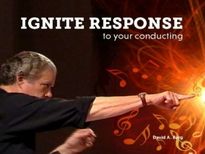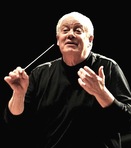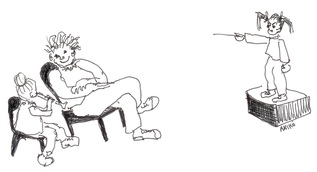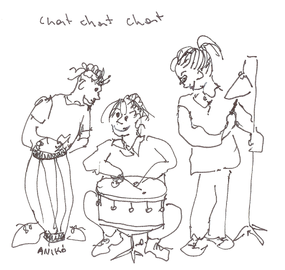Here are excerpts from the chapter on Get Results with Experience more than Information from Igniting Response (to our conducting), Publication: 2019
If you'd like us to notify you when Igniting Response (to our conducting) is available, click here. We won't sell, give, barter, gift, re-gift or lend your information to anyone. That's a promise!!!
If you'd like us to notify you when Igniting Response (to our conducting) is available, click here. We won't sell, give, barter, gift, re-gift or lend your information to anyone. That's a promise!!!
Giving your students an experience of what you want will make it happen.
Merely giving information - “Measures 24 and 25 should be louder!” – then moving on without the students' experiencing the fortissimo you want – will not.
We might think that telling our kids to “Play louder!!!” will get them to do it at the next rehearsal (and the next, and the next and, eventually, at the concert). But, as we all know, it won’t. Why? Because information can't become practice without experience and drilling – it’s only one of the first steps in the process of creating the desired result.
Merely giving information - “Measures 24 and 25 should be louder!” – then moving on without the students' experiencing the fortissimo you want – will not.
We might think that telling our kids to “Play louder!!!” will get them to do it at the next rehearsal (and the next, and the next and, eventually, at the concert). But, as we all know, it won’t. Why? Because information can't become practice without experience and drilling – it’s only one of the first steps in the process of creating the desired result.
Don’t we know this from our student days?
Our teachers gave us information at lessons. We practiced that information at
home – again and again - until we experienced translating information into
practice.
Had information been enough, we wouldn’t have needed to practice!
We would have been able to do what our teachers told us without it!
Our teachers gave us information at lessons. We practiced that information at
home – again and again - until we experienced translating information into
practice.
Had information been enough, we wouldn’t have needed to practice!
We would have been able to do what our teachers told us without it!
Experience makes the Most of your Rehearsal Time
When we get our students to actually experience what our information asks for - “Louder!” or “Softer” or “Watch Me at letter C” or “Trumpets, don’t drown out the oboes’ melody.” - we multiply the value of our (too little) rehearsal time.
When we don’t, not only do we waste precious minutes, but we also send messages like:
If students don't experience improvement...if they know we won't hold them responsible for following our instructions... their trust and commitment are likely to weaken and they may become dispirited. Although And we sometimes blame them for not following our instructions…it’s really our fault that they don't.
We should remember that, as musicians in ensembles, we knew it was
usually the conductors’ fault when things didn’t go right. Now that we’re
conductors, we should remember that!
So: When you make a comment, drill that comment; not doing this is one of the main reasons many of us don’t have enough rehearsal time.
When we get our students to actually experience what our information asks for - “Louder!” or “Softer” or “Watch Me at letter C” or “Trumpets, don’t drown out the oboes’ melody.” - we multiply the value of our (too little) rehearsal time.
When we don’t, not only do we waste precious minutes, but we also send messages like:
- “What I say doesn’t matter and you don’t have to do it.”
- “Since you don’t have to do what I say: you don’t have to listen, either.”
- “We’ll have to go over and over the same spots because we’re not getting it right.” (…and: “I don’t know how to fix it.”)
If students don't experience improvement...if they know we won't hold them responsible for following our instructions... their trust and commitment are likely to weaken and they may become dispirited. Although And we sometimes blame them for not following our instructions…it’s really our fault that they don't.
We should remember that, as musicians in ensembles, we knew it was
usually the conductors’ fault when things didn’t go right. Now that we’re
conductors, we should remember that!
So: When you make a comment, drill that comment; not doing this is one of the main reasons many of us don’t have enough rehearsal time.
- If you want the altos to watch you when they enter: drill it! and drill it tomorrow and the next day and the next…until it’s in their muscle memory;
- When you tell the trumpets to play softer: drill it! and drill it tomorrow and the next day and the next…until it’s in their muscle memory;
- When the lower strings are told to watch the violinists’ bows to enter at the right speed: drill it! and drill it tomorrow and the next day and the next…until it’s in their muscle memory.
USE THE POWER OF EXPERIENCE TO:
Make them aware of the importance of posture:
Instead of giving them information: “It’s important to stand up straight! …or calling out: “Posture!”:
Help them understand how much better they sing/play with good posture
Instead of giving them information: “It’s simply impossible to play well with bad posture!”
Make them aware of the importance of posture:
Instead of giving them information: “It’s important to stand up straight! …or calling out: “Posture!”:
- Walk to the podium in different ways – proud and up straight; hunched over with your head down; tense, rushing in and looking at your watch; you can come up with others;
- Then ask students what message your posture is sending them: “I’m jazzed and ready to lead a great rehearsal?” “I’m tired and not happy about being here?” etc.
- Then ask how they feel when they see you with good posture? …and with bad? “How do these feelings affect your participation?” “Do they make you want to do you very best?” …or not?
- Then ask them: “And what message is my posture sending me?” If they don’t understand, help by asking whether “…my posture is sending me the message that I am confident, happy to be here, and going to lead an exciting rehearsal?” …or not.
- Giving them this experience will help them understand the powerful role of posture in music-making – and in life, generally; shouting out “Posture is important!” from time to time… will not.
Help them understand how much better they sing/play with good posture
Instead of giving them information: “It’s simply impossible to play well with bad posture!”
- Have them all shlump down in their chairs (they’ll enjoy this!), then ask them to play a fff or molto espressivo passage sitting that way.
- Then ask them to sit up straight, legs uncrossed, feet flat on the floor, heads up and shoulders back…and play the same passage; is there a difference?
- There will be and they’ll experience – even without your telling them – how strongly posture influences behavior.
|
Quiet them down
Instead of giving them information: “Be quiet – we can’t get anything done when you start talking as soon as I stop!” |
|
|
Create attention
Instead of giving them information: “Pay Attention! Listen when I talk or you’ll miss what I’m saying…”
b. care about them as people, not only as singers or instrumentalists, and;
c. respect their intelligence and ability to learn from sophisticated teaching.
And this will have a remarkable effect on your rapport, the culture of the ensemble, and the level of the music-making.
Get them to watch
Create better Dynamics
Instead of giving them information: “That needs to be louder. Don’t you see it’s marked ff?!”
You’ll surely be able to think of dozens more ways to apply the “Experience Factor.”
Instead of giving them information: “Pay Attention! Listen when I talk or you’ll miss what I’m saying…”
- Ask someone to raise her hand – she urgently needs to tell you something important – but you pretend not to notice. Or tell the students to raise their hands to let you know there’s a fire in the room.
- Pretend not to notice anything; ignore everyone. Ask the group how it feels when they need your attention but can’t get it. Be patient and don’t go on until students begin speaking.
- (This is great): Tell someone in the front to ask you: “What’s your name? (it might take a minute or so for this to happen). Look right at that person with a blank look (deer in the headlights). Do not respond. Roll your eyes a little (like they do); put a “Whatever!” expression on your face.
- Wait some seconds. Then ask him/her to ask again – still response from you. Then again.
- After a few times, they’ll experience what it’s like not to have someone’s attention, since they ignore such comments as: “You’re not paying attention; Pay Attention!”
- This approach is very, very powerful - and not only because of its immediate effect.
- At a deeper level – if you’re consistent over time - the students will understand that you:
b. care about them as people, not only as singers or instrumentalists, and;
c. respect their intelligence and ability to learn from sophisticated teaching.
And this will have a remarkable effect on your rapport, the culture of the ensemble, and the level of the music-making.
Get them to watch
- Instead of giving them information: “It’s so important to watch me!”
- Give them an experience of how much fun it can be when they do watch.
- Have them hold a note and watch you. Conduct a crescendo, then a decrescendo in rapid succession, then again…and again…each time faster.
- Punch out a mighty ff attack, then indicate a rapid diminuendo followed by a slow crescendo to a screaming ffff!
- (You choose what to do, but) If you’re enjoying yourself, your gestures are clear, expressive and highly intended (as usual, right?!)…and if your face expresses the same thing as the rest of your body…they’re sure to watch and follow you and experience the fun and dramatic results of watching.
- And with gentle reminders, they’ll want to watch and follow in the music you’re rehearsing.
- Young musicians at all levels usually love this and have a great time; try this approach to sharpen attention, increase understanding of your gestures, and have a rollicking change of pace.
Create better Dynamics
Instead of giving them information: “That needs to be louder. Don’t you see it’s marked ff?!”
- Have them sing/play the note/notes in question ff.
- Ask for it louder, then louder, then louder still. Ask them if they can sing/play it twice as loud…then twice as loud as that.
- Suggest something horrid will happen (in high school - that they’ll never get their driver’s license) if they don’t sing/play it at their absolute physical limit – right now!
- Keep insisting with energy and urgency: you will get the ff you really want but thought would never happen if- IF - you don’t give up (in a good natured, encouraging way, of course).
- This will give them the experience of working long and hard on one thing and achieving an inspiring – often unprecedented result.
- It can take 5-10 minutes but you’re sure to get the fortissimo you want, and – because it was so strong and so cool and so clearly better than anything they did before…they’re likely to do it the next time (as well as transferring that learning to other dynamics elsewhere in the piece)!
You’ll surely be able to think of dozens more ways to apply the “Experience Factor.”




